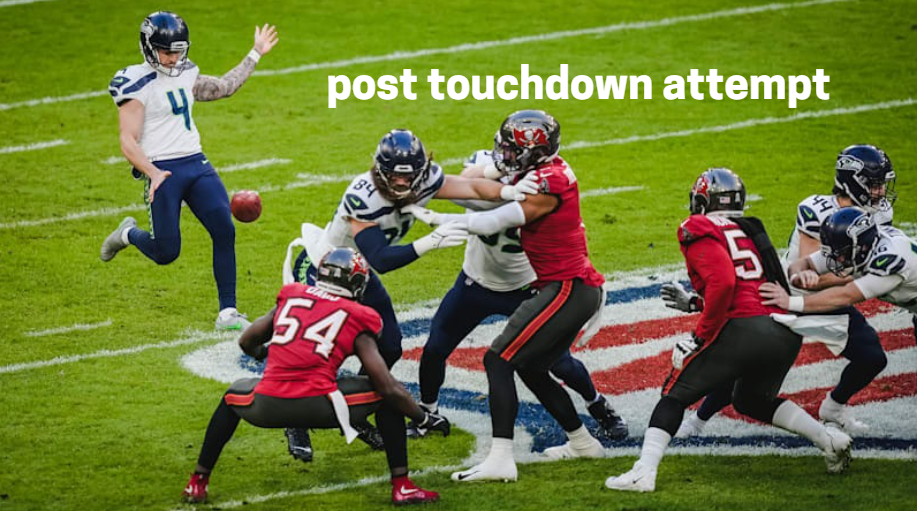Post touchdown attempts, also known as conversion attempts or extra points, are a crucial part of American football that can significantly impact the outcome of a game. After a team scores a touchdown, they have the opportunity to earn additional points through various methods.
This article aims to provide an in-depth understanding of post touchdown attempts, their significance, strategies, and the rules governing them. By delving into this topic, we aim to offer insights and analyses that go beyond existing information, ensuring a thorough and engaging read for football enthusiasts in the USA.
Contents
- 1 Introduction to Post Touchdown Attempts
- 2 Types of Post Touchdown Attempts
- 3 Rules and Regulations
- 4 Strategies for Post Touchdown Attempts
- 5 Historical Overview
- 6 Impact on Game Outcomes
- 7 Coaching Perspectives
- 8 Player Perspectives
- 9 Fan Perspectives
- 10 Statistical Analysis
- 11 Future Trends
- 12 FAQs
- 12.1 What is a post touchdown attempt?
- 12.2 How many points is a one-point conversion worth?
- 12.3 How many points is a two-point conversion worth?
- 12.4 What is the success rate of one-point conversions in the NFL?
- 12.5 What is the success rate of two-point conversions in the NFL?
- 12.6 When should a team attempt a two-point conversion?
- 13 Conclusion
Introduction to Post Touchdown Attempts
A post touchdown attempt occurs immediately after a team scores a touchdown. The team that scored can then choose to attempt a one-point or two-point conversion to add to their score.
The decision on which type of conversion to attempt is strategic and can vary depending on the game’s context, the team’s confidence in their play, and their opponent’s weaknesses.
Types of Post Touchdown Attempts
One-Point Conversion
The one-point conversion, also known as the extra point or PAT (Point After Touchdown), is the most common type of post touchdown attempt. It involves kicking the ball through the opponent’s goalposts from the 15-yard line (effectively a 33-yard kick due to the position of the goalposts in the end zone).
Advantages of One-Point Conversion:
- Higher success rate (approximately 94% in the NFL).
- Provides a reliable and low-risk way to add an extra point.
Disadvantages of One-Point Conversion:
- Only adds one point to the score.
- May be less impactful in situations where a team needs more points quickly.
Two-Point Conversion
The two-point conversion is a more challenging but potentially more rewarding option. It involves running a play from the two-yard line with the goal of crossing the opponent’s goal line again, similar to scoring a short touchdown.
Advantages of Two-Point Conversion:
- Adds two points to the score.
- Can be a game-changer in close matches, allowing a team to potentially tie or take the lead.
Disadvantages of Two-Point Conversion:
- Lower success rate (approximately 47.9% in the NFL).
- Higher risk, as failing to convert means missing out on potential points.
Rules and Regulations
The rules governing post touchdown attempts are outlined by the National Football League (NFL) and other football organizations. Key regulations include:
- The one-point conversion is attempted from the 15-yard line.
- The two-point conversion is attempted from the two-yard line.
- Defensive teams can score two points by returning a blocked extra point or a failed two-point attempt to their own end zone.
Strategies for Post Touchdown Attempts
When to Attempt a One-Point Conversion
- Early in the Game: Teams often choose the safer one-point conversion early in the game to build a steady lead.
- Strong Kicking Game: Teams with reliable kickers may prefer the one-point conversion due to its high success rate.
- Minimal Impact on Outcome: If the additional point does not significantly affect the game’s outcome, a one-point conversion is a safer bet.
When to Attempt a Two-Point Conversion
- Late in the Game: Teams trailing by a specific number of points may attempt a two-point conversion to tie or take the lead.
- Offensive Strength: Teams with a strong short-yardage offense may feel confident in their ability to execute a two-point conversion.
- Desperation or Momentum: In critical moments or when needing a momentum shift, teams might opt for the higher reward of a two-point conversion.
Historical Overview
The concept of post touchdown attempts has evolved over the years. Initially, the one-point conversion was the only option available. The introduction of the two-point conversion added a new strategic element to the game, giving teams more options to influence the score.
This section will delve into key moments and changes in the history of post touchdown attempts, highlighting significant games and decisions that have shaped current strategies.
Impact on Game Outcomes
Post touchdown attempts can significantly affect the outcome of a game. Successful conversions can change the score dynamics, influence play-calling decisions, and alter the psychological momentum of a team. Analyzing past games where post touchdown attempts played a crucial role can provide valuable insights into their importance.
Coaching Perspectives
Coaches play a pivotal role in deciding which post touchdown attempt to make. Their decisions are influenced by various factors, including game context, team strengths, and opponent weaknesses.
This section will explore different coaching philosophies and strategies related to post touchdown attempts, featuring insights from renowned coaches.
Player Perspectives
Players’ perspectives on post touchdown attempts can vary based on their roles and experiences. Kickers may feel the pressure of consistently making extra points, while offensive players relish the challenge of executing a successful two-point conversion.
This section will include interviews and anecdotes from players, offering a behind-the-scenes look at their thoughts and emotions during these critical moments.
Fan Perspectives
Fans often have strong opinions about post touchdown attempts, as these decisions can evoke intense emotions during a game. Understanding fan perspectives can provide a broader view of the cultural significance of post touchdown attempts in American football. This section will feature fan reactions, social media highlights, and the overall impact on the viewing experience.
Statistical Analysis
A thorough statistical analysis of post touchdown attempts can reveal trends and patterns that help teams make informed decisions.
This section will present data on success rates, game outcomes, and other relevant metrics, providing a comprehensive view of the effectiveness of one-point versus two-point conversions.
Future Trends
As football continues to evolve, so too will strategies related to post touchdown attempts. This section will explore potential future trends, such as changes in rules, advancements in analytics, and how evolving offensive and defensive strategies might impact post touchdown attempts.
FAQs
What is a post touchdown attempt?
A post touchdown attempt is the opportunity for a team to score additional points immediately after scoring a touchdown. The team can choose between a one-point conversion (kicking the ball through the goalposts) or a two-point conversion (running a play from the two-yard line).
How many points is a one-point conversion worth?
A one-point conversion is worth one point, adding a single point to the team’s score after a touchdown.
How many points is a two-point conversion worth?
A two-point conversion is worth two points, adding two points to the team’s score after a touchdown.
What is the success rate of one-point conversions in the NFL?
The success rate of one-point conversions in the NFL is approximately 94%.
What is the success rate of two-point conversions in the NFL?
The success rate of two-point conversions in the NFL is approximately 47.9%.
When should a team attempt a two-point conversion?
A team should consider attempting a two-point conversion in situations where they need more points to tie or take the lead, particularly late in the game or when they have confidence in their short-yardage offense.
Conclusion
Post touchdown attempts are a vital aspect of American football that requires strategic decision-making and precise execution. Whether opting for the safer one-point conversion or the riskier two-point conversion, teams must weigh various factors to maximize their scoring potential.
By understanding the intricacies of post touchdown attempts, fans and analysts can better appreciate the strategic depth of the game and its ever-evolving nature.





















+ There are no comments
Add yours